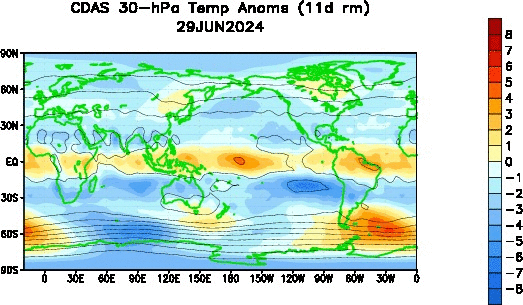There are hints that there may be another winter storm across the Midwest and Northeast through the December 13-16 timeframe.
The GFS model has a storm system moving north and east across the lower Midwest and towards the Northeast, as is shown by the elevated vorticity values over the Kentucky, Illinois, Indiana and into Tennessee. The GFS prefers to develop this storm system, and moves it northeast over the ridging in the Southeast, giving the Midwest, Lower Great Lakes, Ohio Valley and Northeast another round of snow. Given that the pattern does support this storm track, I do think that this is within the realm of possibility.
The ECMWF, at the same timeframe as the GFS image above, has this energy more elongated than the GFS, and it is not developed correctly as a result. Both model systems have ridging over the West Coast, as well as ridging in the Southeast, which is why I find this solution rather peculiar. I think the ECMWF may not be correct in its analysis of the system. Let's discuss why below.
For one, the ECMWF ensemble set (ECMWF EPS) follows the same track (drawn in yellow) that the 12z GFS put up earlier today. Both model guidance sets have the storm system traveling from northern Mississippi to West Virginia. Looking at the deviation on the image above, it does look like the ensemble members agree with the GFS, with dark blues rather than light blues (which would indicate low confidence in the solution) showing up for this potential storm. If we are to go by the idea that the ECMWF EPS and GFS are pairing up for this potential winter storm, we can take a look at the overall storm projection from the GFS and see what both guidance systems may be thinking:
As the GFS projects above, this storm would bring plowable snows from much of Illinois to Indiana, Michigan, Ohio, Pennsylvania, New York, Vermont, New Hampshire, and Maine. I don't have the figures on the ECMWF ensemble snowfall (not sure if anyone has access to that), but based on the storm track from the GFS and ECMWF EPS matching up so well, I would think that snowfall orientation would be the same, stretching from the Midwest to the Northeast.
I'd like to wait for a bit more consistency before putting in more confidence to this system, which would include the GFS and ECMWF EPS matching up again on this system, and even the ECMWF operational model jumping on board.
Andrew
The GFS model has a storm system moving north and east across the lower Midwest and towards the Northeast, as is shown by the elevated vorticity values over the Kentucky, Illinois, Indiana and into Tennessee. The GFS prefers to develop this storm system, and moves it northeast over the ridging in the Southeast, giving the Midwest, Lower Great Lakes, Ohio Valley and Northeast another round of snow. Given that the pattern does support this storm track, I do think that this is within the realm of possibility.
The ECMWF, at the same timeframe as the GFS image above, has this energy more elongated than the GFS, and it is not developed correctly as a result. Both model systems have ridging over the West Coast, as well as ridging in the Southeast, which is why I find this solution rather peculiar. I think the ECMWF may not be correct in its analysis of the system. Let's discuss why below.
For one, the ECMWF ensemble set (ECMWF EPS) follows the same track (drawn in yellow) that the 12z GFS put up earlier today. Both model guidance sets have the storm system traveling from northern Mississippi to West Virginia. Looking at the deviation on the image above, it does look like the ensemble members agree with the GFS, with dark blues rather than light blues (which would indicate low confidence in the solution) showing up for this potential storm. If we are to go by the idea that the ECMWF EPS and GFS are pairing up for this potential winter storm, we can take a look at the overall storm projection from the GFS and see what both guidance systems may be thinking:
 |
| Note, this storm would bring snows to the northern Northeast regions, not coastal states. Subtract an inch or two from western New York, VT, NH, ME, northwestern PA to get snow from only this storm. |
I'd like to wait for a bit more consistency before putting in more confidence to this system, which would include the GFS and ECMWF EPS matching up again on this system, and even the ECMWF operational model jumping on board.
Andrew








